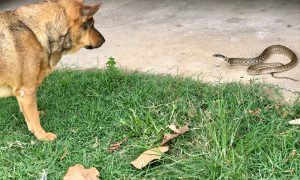“This post contains affiliate links, and I will be compensated if you make a purchase after clicking on my links.”
A California man credits his dog, Tumbleweed with potentially saving his life when the 5-year old Husky mix protected him from a rattlesnake on Sunday afternoon.
David Crowell was picking plums when Tumbleweed came running toward him. That’s when he looked down and noticed a rattlesnake at his own feet. About an hour later, Crowell noticed Tumbleweed beginning to swell up and realized his heroic dog had been bitten on the nose by the snake. He rushed his best friend to the veterinarian where he was treated with antivenin, antibiotics, and and antihistamine. Lucky for both Crowell and Tumbleweed, the dog responded well to treatment and is expected to make a full recovery.
But, Crowell’s close encounter serves as an important reminder to pet parents. While rattlesnakes are most common in the southwest, they can, and do, thrive in nearly all 50 states (Click here to see a list of rattlesnakes and other venomous snakes living in your state). And, while snakes don’t generally strike unless provoked, they pose a particular threat to curious pets. It is estimated that roughly 300,000 dogs and cats are bitten by venomous snakes every year. Many dogs are not as lucky as Tumbleweed.
Parents to pets living in an area common to venomous snakes, hunting dogs, search and rescue dogs, and those who spend a lot of time outdoors hiking or camping can benefit from a rattlesnake vaccine.
The rattlesnake vaccine, Crotalus Atrox Toxoid, was developed to protect dogs against Western Diamondback Rattlesnake venom, but venom from many other snakes found throughout the United States is similar to the venom of the Western Diamondback Rattlesnake meaning this vaccine may also provide protection against the venoms of the Western Rattlesnake (including the Prairie, Great Basin, Northern and Southern Pacific varieties), Sidewinder, Timber Rattlesnake, Massasauga and the Copperhead, and partial protection against Eastern Diamondback Rattlesnake venom. Learn more about the vaccine and the risks and benefits by clicking here.
Dogs who have been vaccinated experience less swelling, less pain, less tissue damage, and faster recovery time than non-vaccinated dogs. Still, there are risks associated with this, and any other vaccine. Dog owners should weigh the risks versus the reward of being vaccinated and discuss the option with a veterinarian that knows their dog’s health history.
DesertUSA provides some additional tips to prevent your dog from being bitten by a snake including:
- Always keep your dog on a leash when outside of your home or away from your yard.
- Don’t let your dog wander into tall grass or thick shrubs where snakes may be hiding.
- Be careful along streams and riverbeds as snakes are often found in the tall grass near water sources.
- If you encounter a rattlesnake stay a minimum of 10′ or more away from the snake and walk around the area or take another route.
- Always have a nearby 24/7 Vet Hospital phone number and address with you when you venture out to hike with your dog and keep emergency numbers in an easy to find location at home.
- Enroll your dog in a Rattlesnake Avoidance Class from a local dog trainer who has experience training dogs to avoid rattlesnakes.
- Ask your vet if he or she feels a rattlesnake vaccine is appropriate for your dog.
And, be sure to snake-proof your own backyard, too!
- Keep the grass in your front and back yards cut short.
- Clean up any debris in your yard including piles of wood, leaves, or any other materials that a snake could hide under.
- Control rodents in your yard and around your home: pick up fruit on the ground, keep trash cans closed with lids and don’t leave pet food out.
- Remove birdfeeders as they attract small rodents which rattlesnakes prey on.
- Add a rattlesnake proof fence around your yard
- Keep any vegetation from growing up or over the fence as snakes can use it as a way over the fence.
- Check under your house and around the perimeter to close any gaps or holes where a rattlesnake could hide.
- Fill in or block any holes or gaps were a snake can hide or slip through the fence or under your house.






















